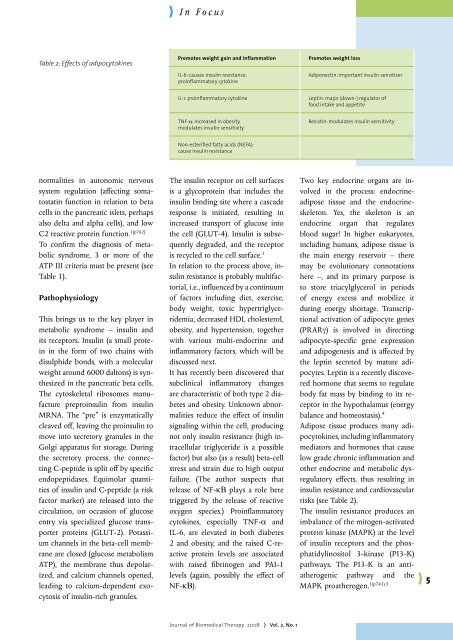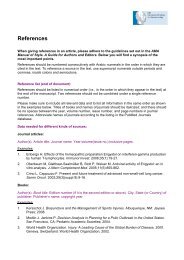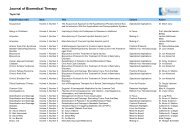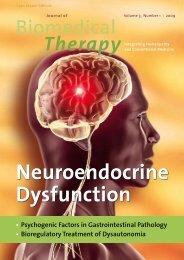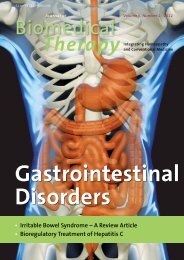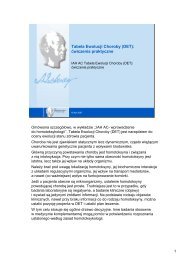Metabolic Syndrome - International Academy of Homotoxicology
Metabolic Syndrome - International Academy of Homotoxicology
Metabolic Syndrome - International Academy of Homotoxicology
Create successful ePaper yourself
Turn your PDF publications into a flip-book with our unique Google optimized e-Paper software.
) In Focus<br />
Table 2: Effects <strong>of</strong> adipocytokines<br />
Promotes weight gain and inflammation<br />
IL-6: causes insulin resistance,<br />
proinflammatory cytokine<br />
Promotes weight loss<br />
Adiponectin: important insulin sensitizer<br />
IL-1: proinflammatory cytokine<br />
Leptin: major (down-) regulator <strong>of</strong><br />
food intake and appetite<br />
TNF-α: increased in obesity,<br />
modulates insulin sensitivity<br />
Resistin: modulates insulin sensitivity<br />
Non-esterified fatty acids (NEFA):<br />
cause insulin resistance<br />
normalities in autonomic nervous<br />
system regulation (affecting somatostatin<br />
function in relation to beta<br />
cells in the pancreatic islets, perhaps<br />
also delta and alpha cells), and low<br />
C2 reactive protein function. 1(p742)<br />
To confirm the diagnosis <strong>of</strong> metabolic<br />
syndrome, 3 or more <strong>of</strong> the<br />
ATP III criteria must be present (see<br />
Table 1).<br />
Pathophysiology<br />
This brings us to the key player in<br />
metabolic syndrome – insulin and<br />
its receptors. Insulin (a small protein<br />
in the form <strong>of</strong> two chains with<br />
disulphide bonds, with a molecular<br />
weight around 6000 daltons) is synthesized<br />
in the pancreatic beta cells.<br />
The cytoskeletal ribosomes manufacture<br />
preproinsulin from insulin<br />
MRNA. The “pre” is enzymatically<br />
cleaved <strong>of</strong>f, leaving the proinsulin to<br />
move into secretory granules in the<br />
Golgi apparatus for storage. During<br />
the secretory process, the connecting<br />
C-peptide is split <strong>of</strong>f by specific<br />
endopeptidases. Equimolar quantities<br />
<strong>of</strong> insulin and C-peptide (a risk<br />
factor marker) are released into the<br />
circulation, on occasion <strong>of</strong> glucose<br />
entry via specialized glucose transporter<br />
proteins (GLUT-2). Potassium<br />
channels in the beta-cell membrane<br />
are closed (glucose metabolism<br />
ATP), the membrane thus depolarized,<br />
and calcium channels opened,<br />
leading to calcium-dependent exocytosis<br />
<strong>of</strong> insulin-rich granules.<br />
The insulin receptor on cell surfaces<br />
is a glycoprotein that includes the<br />
insulin binding site where a cas cade<br />
response is initiated, resulting in<br />
increased transport <strong>of</strong> glucose into<br />
the cell (GLUT-4). Insulin is subsequently<br />
degraded, and the receptor<br />
is recycled to the cell surface. 3<br />
In relation to the process above, insulin<br />
resistance is probably multifactorial,<br />
i.e., influenced by a continuum<br />
<strong>of</strong> factors including diet, exercise,<br />
body weight, toxic hypertriglyceridemia,<br />
decreased HDL cholesterol,<br />
obesity, and hypertension, together<br />
with various multi-endocrine and<br />
inflammatory factors, which will be<br />
discussed next.<br />
It has recently been discovered that<br />
subclinical inflammatory changes<br />
are characteristic <strong>of</strong> both type 2 diabetes<br />
and obesity. Unknown abnormalities<br />
reduce the effect <strong>of</strong> insulin<br />
signaling within the cell, producing<br />
not only insulin resistance (high intracellular<br />
triglyceride is a possible<br />
factor) but also (as a result) beta-cell<br />
stress and strain due to high output<br />
failure. (The author suspects that<br />
release <strong>of</strong> NF-kB plays a role here<br />
triggered by the release <strong>of</strong> reactive<br />
oxygen species.) Proinflammatory<br />
cytokines, especially TNF-a and<br />
IL-6, are elevated in both diabetes<br />
2 and obesity, and the raised C-reactive<br />
protein levels are associated<br />
with raised fibrinogen and PAI-1<br />
levels (again, possibly the effect <strong>of</strong><br />
NF-kB).<br />
Two key endocrine organs are involved<br />
in the process: endocrineadipose<br />
tissue and the endocrineskeleton.<br />
Yes, the skeleton is an<br />
endocrine organ that regulates<br />
blood sugar! In higher eukaryotes,<br />
including humans, adipose tissue is<br />
the main energy reservoir – there<br />
may be evolutionary connotations<br />
here –, and its primary purpose is<br />
to store triacylglycerol in periods<br />
<strong>of</strong> energy excess and mobilize it<br />
during energy shortage. Transcriptional<br />
activation <strong>of</strong> adipocyte genes<br />
(PRARg) is involved in directing<br />
adipocyte-specific gene expression<br />
and adi pogenesis and is affected by<br />
the leptin secreted by mature adipocytes.<br />
Leptin is a recently discovered<br />
hormone that seems to regulate<br />
body fat mass by binding to its receptor<br />
in the hypothalamus (energy<br />
balance and homeostasis). 4<br />
Adipose tissue produces many adipocytokines,<br />
including inflammatory<br />
mediators and hormones that cause<br />
low grade chronic inflammation and<br />
other endocrine and metabolic dysregulatory<br />
effects, thus resulting in<br />
insulin resistance and cardiovascular<br />
risks (see Table 2).<br />
The insulin resistance produces an<br />
imbalance <strong>of</strong> the mitogen-activated<br />
protein kinase (MAPK) at the level<br />
<strong>of</strong> insulin receptors and the phosphatidylinositol<br />
3-kinase (PI3-K)<br />
pathways. The PI3-K is an antiatherogenic<br />
pathway and the<br />
MAPK proatherogen. 1(p743),5 ) 5<br />
Journal <strong>of</strong> Biomedical Therapy 2008 ) Vol. 2, No. 1


